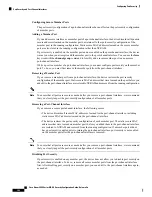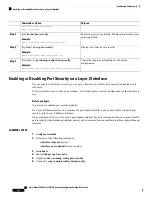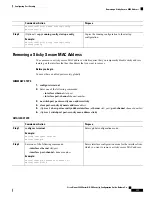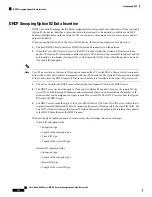
Purpose
Command or Action
Copies the running configuration to the startup
configuration.
(Optional)
copy running-config startup-config
Example:
Step 6
switch(config-if)# copy running-config
startup-config
Configuring a Security Violation Action
You can configure the action that the device takes if a security violation occurs. The violation action is
configurable on each interface that you enable with port security.
The default security action is to shut down the port on which the security violation occurs.
Before you begin
You must have enabled port security globally.
SUMMARY STEPS
1.
configure terminal
2.
Enter one of the following commands:
•
interface ethernet slot
/
port
•
interface port-channel channel-number
3.
[
no
]
switchport port-security violation
{
protect
|
restrict
|
shutdown
}
4.
(Optional)
show running-config port-security
5.
(Optional)
copy running-config startup-config
DETAILED STEPS
Purpose
Command or Action
Enters global configuration mode.
configure terminal
Example:
Step 1
switch# configure terminal
switch(config)#
Enters interface configuration mode for the interface that
you want to configure with a security violation action.
Enter one of the following commands:
Step 2
•
interface ethernet slot
/
port
•
interface port-channel channel-number
Example:
switch(config)# interface ethernet 2/1
switch(config-if)#
Configures the security violation action for port security on
the current interface. The
no
option resets the violation
action to the default, which is to shut down the interface.
[
no
]
switchport port-security violation
{
protect
|
restrict
|
shutdown
}
Example:
Step 3
Cisco Nexus 9000 Series NX-OS Security Configuration Guide, Release 9.x
322
Configuring Port Security
Configuring a Security Violation Action






























